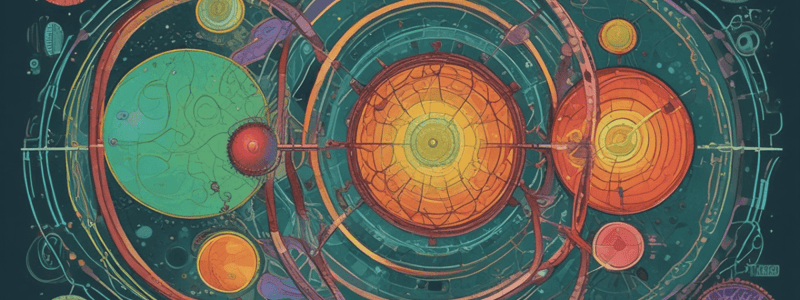Podcast
Questions and Answers
What is the process by which the cytoplasm divides, resulting in two separate cells?
What is the process by which the cytoplasm divides, resulting in two separate cells?
- Cleavage
- Cytokinesis (correct)
- Mitosis
- Meiosis
What occurs during Prophase I of meiosis?
What occurs during Prophase I of meiosis?
- Sister chromatids separate and move to opposite poles
- Homologous chromosomes pair up and exchange genetic material (correct)
- Chromosomes condense and the nuclear envelope breaks down
- Paired chromosomes line up at the center of the cell
What is the result of meiosis?
What is the result of meiosis?
- Four daughter cells with half the number of chromosomes as the parent cell (correct)
- Two daughter cells with half the number of chromosomes as the parent cell
- Two daughter cells with the same number of chromosomes as the parent cell
- Four daughter cells with the same number of chromosomes as the parent cell
What is the process called when a cell plate forms in the center of the cell, dividing the cytoplasm?
What is the process called when a cell plate forms in the center of the cell, dividing the cytoplasm?
During which stage of meiosis do paired chromosomes line up at the center of the cell?
During which stage of meiosis do paired chromosomes line up at the center of the cell?
What is the process called when the cell membrane pinches inward, dividing the cytoplasm?
What is the process called when the cell membrane pinches inward, dividing the cytoplasm?
How many successive cell divisions occur during meiosis?
How many successive cell divisions occur during meiosis?
What is the longest stage of the cell cycle?
What is the longest stage of the cell cycle?
What occurs during the S phase of interphase?
What occurs during the S phase of interphase?
What is the primary result of mitosis?
What is the primary result of mitosis?
During which stage of mitosis do chromosomes line up at the center of the cell?
During which stage of mitosis do chromosomes line up at the center of the cell?
What occurs during the G2 phase of interphase?
What occurs during the G2 phase of interphase?
What is the primary difference between mitosis and meiosis?
What is the primary difference between mitosis and meiosis?
Flashcards are hidden until you start studying
Study Notes
Cell Cycle
The cell cycle is the sequence of events that occur in a cell as it grows, replicates its DNA, and divides into two daughter cells.
Interphase
- Longest stage of the cell cycle
- Cell grows, replicates its DNA, and prepares for cell division
- Three stages:
- G1 phase (Gap 1): Cell grows, increases in size, and prepares for DNA replication
- S phase (Synthesis): DNA replication occurs, resulting in two identical copies of DNA
- G2 phase (Gap 2): Cell prepares for cell division, organelles and proteins are synthesized
Mitosis
- Process of cell division that results in two daughter cells with the same number of chromosomes as the parent cell
- Four stages:
- Prophase: Chromatin condenses into visible chromosomes, nuclear envelope breaks down
- Metaphase: Chromosomes line up at the center of the cell, attached to the spindle fibers
- Anaphase: Sister chromatids separate, moving to opposite poles of the cell
- Telophase: Nuclear envelope reforms, chromosomes uncoil, and nuclei reassemble
Cytokinesis
- Process of cytoplasmic division, resulting in two separate cells
- Occurs after mitosis, and can occur through two mechanisms:
- Cleavage: In animal cells, the cell membrane pinches inward, dividing the cytoplasm
- Cell plate formation: In plant cells, a cell plate forms in the center of the cell, dividing the cytoplasm
Meiosis
- Special type of cell division that occurs in reproductive cells (gametes)
- Results in four daughter cells with half the number of chromosomes as the parent cell
- Two successive cell divisions (meiosis I and meiosis II) occur, with a reduction in chromosome number after each division
- Meiosis I:
- Prophase I: Homologous chromosomes pair up, exchange genetic material (crossing over)
- Metaphase I: Paired chromosomes line up at the center of the cell
- Anaphase I: Homologous chromosomes separate, moving to opposite poles
- Meiosis II:
- Prophase II: Chromosomes condense, nuclear envelope breaks down
- Metaphase II: Chromosomes line up at the center of the cell
- Anaphase II: Sister chromatids separate, moving to opposite poles
Studying That Suits You
Use AI to generate personalized quizzes and flashcards to suit your learning preferences.




